WILLIAM CALEB "CALE" YARBOROUGH - 03/27/1939
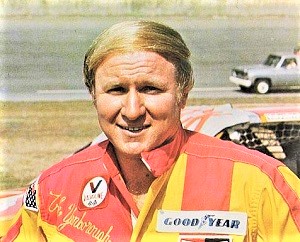
is a farmer, businessman and former NASCAR Cup Series driver and owner. He is one of only two drivers in NASCAR history to win three consecutive championships. He was the second NASCAR driver to appear on the cover of Sports Illustrated (the first was Curtis Turner on the 26 February 1968 issue). Yarborough attended the second annual Southern 500 in 1951 as a young spectator without a ticket (he climbed under the fence). Yarborough was a high school football star and played semi-pro football in Columbia, SC for four seasons and was a Golden Gloves boxer. In 1956 he made his first attempt in the Southern 500 as a teenager by lying about his age, but he was caught and disqualified by NASCAR. In 1957, Yarborough made his debut as a driver at the Southern 500, driving the #30 Pontiac for Bob Weatherly, starting 44th and finishing 42nd after suffering hub problems. He ran for Weatherly two years later, and finished
27th. In 1960, Yarborough ran one race, and had his first career top fifteen, a fourteenth place finish at Southern States Fairgrounds. In 1962, Yarborough ran eight races for Buesink, Don Harrison, and Wildcat Williams. The photo at the right shows Yarborough in a NASCAR Convertible Series race held at Darlington. Although the Convertible Series only raced from 1956-1959 this convertible race carried on as an exception. Points were awarded toward the Cup Series. This is why if you research Cale driving in the NASCAR Convertible Series he is not listed as a participant. This photo was from the final
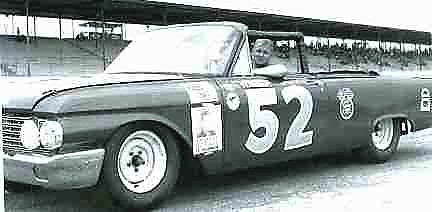
1962 Darlington
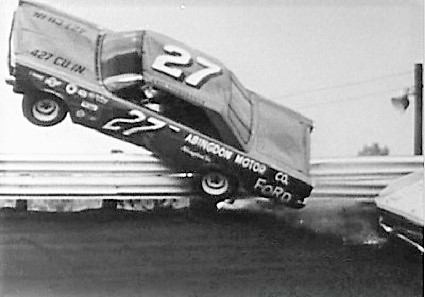
Cale goes out of the park - Darlington 1965
convertible race ever to be held by NASCAR. Yarborough started 17th and finished 13th. The race was won by Nelson Stacy. He earned his first top-ten at the Daytona 500 Qualifying Race, when he finished tenth. Yarborough started 1963 without a full-time ride, but soon signed on to drive the #19 Ford for Herman Beam. His best finish was fifth twice, at Myrtle Beach and Savannah Speedway, respectively. He began the next season driving for Beam, but soon left and finished the year with Holman Moody, finishing sixth at North Wilkesboro Speedway. The next season, he drove for various owners before picking up his first career win at Valdosta Speedway driving the #06 Ford for Kenny Myler. Yarborough drove for Banjo Matthews at the end of the 1965 season, wheeling the #27 Ford. He finished second before years end at North Wilkesboro and at Rockingham. He kicked off the
1966 season with a second place finish in the Daytona 500 and another second place the following race at Rockingham. Despite two consecutive second-place finishes, he left the team early in the season; did not race for several months and ended the year driving the #21 Ford for the Wood Brothers. He won two races in 1967 at the Atlanta 500 and the Firecracker 400. Yarborough also ran the Indianapolis 500 in 1966 and 1967 driving Vollstedt-Fords. After running the season-opening Middle Georgia 500 for Bud Moore Engineering, finishing 21st, Yarborough ran the rest of the season for the Wood Brothers, winning his first Daytona 500 in a duel with Lee Roy Yarbrough, the Firecracker 400, which made him the second driver in history to sweep both Daytona events, and his first Southern 500 garnering a total of six wins that season. In 1969 Ford Motor Company produced
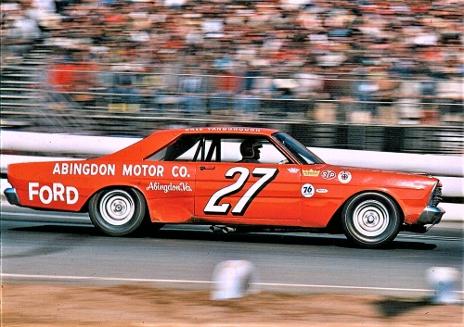
1966 Riverside

1968 Daytona 500
a Cale Yarborough Special Edition Mercury Cyclone Spoiler II. It was a white Mercury Cyclone (fastback) in white with a red roof and stripe. The Spoiler II was outfitted with a special aerodynamic front end. This was a limited edition homologation special that was made to satisfy the NASCAR 500-car minimum production regulations. There was only one engine choice available in the Mercury Cyclone Spoiler II, a 351 cubic inch Windsor. A very similar car was also produced by Mercury in 1969 as a white car with blue trim as the "Dan Gurney Special". Yarborough continued to drive a limited schedule for the Wood Brothers in 1970, winning his second consecutive Michigan 400 and the American 500 for the first time. At the end of the season, Yarborough was released after Ford withdrew factory support for NASCAR teams. He drove four races
in 1971, posting one top-ten in Daytona in the #3 Ray Fox-owned Plymouth. He also ran in the Indianapolis 500, finishing 16th in a Gene White owned, Firestone sponsored Mongoose-Ford. Yarborough mostly focused on driving USAC races in 1971 and 1972. He also ran his final Indianapolis 500 in a Bill Daniels sponsored Atlanta-Foyt, finishing 10th. In 1973, Yarborough returned to NASCAR and ran every NASCAR Grand National race in a season for the first time in his career, driving the #11 Kar-Kare Chevrolet for Richard Howard. He won four races, including his second Southern 500, the National 500 and the Southeastern 500 at Bristol in which he led every lap, and had nineteen top-tens, finishing second in points. In 1974, Yarborough won a career-high ten races, but lost the
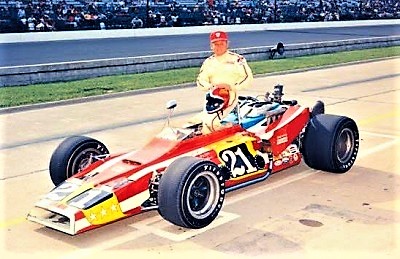
1972 Indy 500
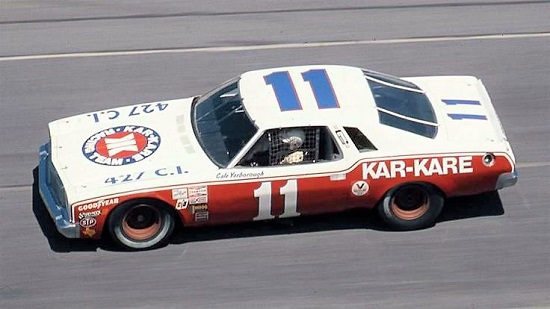
1973 Daytona 500
championship by nearly 600 points. Midway through the season, Yarborough's team was bought by Junior Johnson with Carling sponsorship. Yarborough swept both races at Riverside International Raceway, captured his fourth Atlanta 500, and his second consecutive Southern 500 and third overall. Despite his successful 1974 campaign, the team began 1975 without major sponsorship, and missed three races, before Holly Farms became the team's primary sponsor. The following season, Yarborough won nine races, including four in row late in the season along with the Firecracker 400, in winning his first career Cup Championship. He repeated his nine-win performance in 1977, a season in which he finished
every race and did not finish outside of the top-five during the last eleven races of the season, earning him his second championship. Another highlight of the season was his second Daytona 500 victory, earning him a cover appearance on Sports Illustrated, the second NASCAR driver so honored. He also scored two victories in IROC IV, finishing second in the standings. In 1978, his team switched to Oldsmobiles and received new sponsorship from 1st National City Travelers Checks. He matched his previous career high of 10 wins, including leading every lap
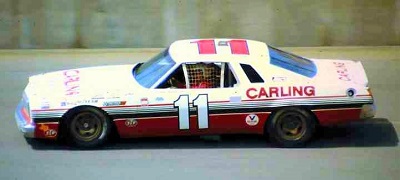
1974 Daytona 500
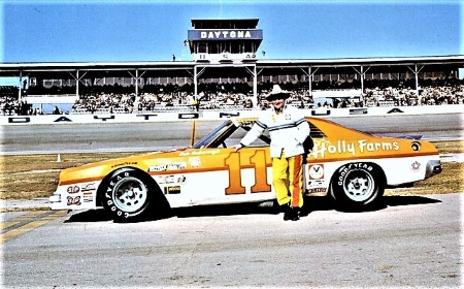
1976 Daytona 500
of the Nashville 420, his fourth Southern 500 and first Winston 500 at Talladega, and won his third consecutive championship. Yarborough began the 1979 season with Busch Beer sponsorship and getting into a fight with Donnie and Bobby Allison after the Daytona 500, when Donnie and Yarborough wrecked while racing for the lead on the final lap. This was the first NASCAR 500 mile race to be broadcast on live TV in its entirety (through CBS Sports). The confrontation and the exciting race that led up to it are credited with starting the mass growth of NASCAR. Yarborough won a career-high and modern-era record fourteen poles in 1980, captured six races including sweeping the events at Rockingham, and scoring wins at Bristol, Michigan, Texas and Atlanta. Yarborough barely
missed out on his fourth championship in five years, losing the championship to Dale Earnhardt by 19 points. At the end of the season, Yarborough announced he was leaving the Junior Johnson team and would run a part-time schedule for the rest of his career. He was replaced by Darrell Waltrip. Yarborough won 55 races while driving for Johnson from 1973–1980, compiling an amazing winning percentage of 26%. Yarborough competed in 18 races in the 1981 season in the #27 Valvoline Buick for M.C. Anderson, winnings his fourth Firecracker 400 and his fifth Coca-Cola 500 at Atlanta, finishing in the top-ten a total of six times. Yarborough competed in 16 races in 1982, winning three, including his hometown Southern 500 for the fifth and final time. In 1983, Anderson closed his
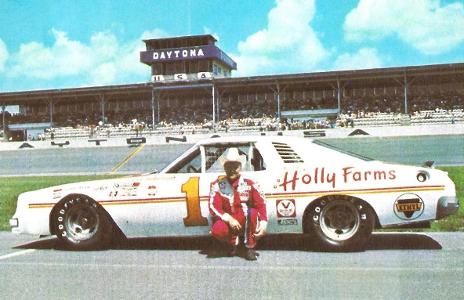
1977 Daytona 500
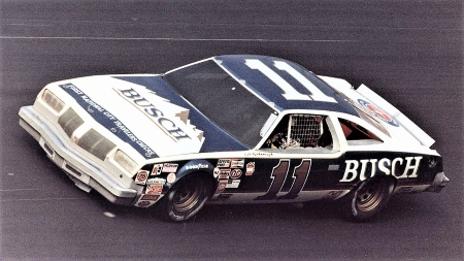
1979 Daytona 500
operation, and Yarborough moved to the #28 Hardee's Chevrolet owned by Harry Ranier, competing in 16 events. He won four races, including his third Daytona 500, his sixth Atlanta Coca-Cola 500, and swept both events at Michigan. In 1984 he repeated by winning his fourth Daytona 500, becoming the second driver to score back-to-back wins, the Winston 500 at Talladega, a race that featured 75 lead changes, and the Van Scoy Diamond Mine 500. Yarborough also captured the IROC VIII championship. In 1985 after his team switched to a Ford, he won his first Talladega 500 and scored his final win in the Miller High Life 500 at Charlotte Motor Speedway. In 1986, Yarborough won his final career pole
at the Firecracker 400. In 1987, he left the Ranier-Lundy team and purchased Jack Beebe's Race Hill Farm team. Yarborough took the Hardee's sponsorship and began running the #29 Oldsmobile Delta 88 as an owner/ driver, posting two top-five finishes. He ran his final season in 1988 in an Oldsmobile Cutlass Supreme, entering ten races and posting two ninth place finishes. He retired at the end of the year. Cale Yarborough bought out the Race Hill Farms team in 1986 and moved the team from Connecticut to South Carolina and he renamed the team Cale Yarborough Motorsports. He got one win in 1997 at the Pepsi 400 with John Andretti wheeling the RCA sponsored Ford. Andretti beat out Terry Labonte by
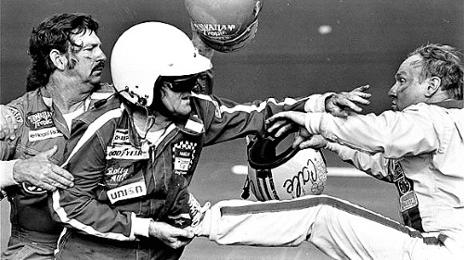
after 1979 Daytona 500 "The Fight"
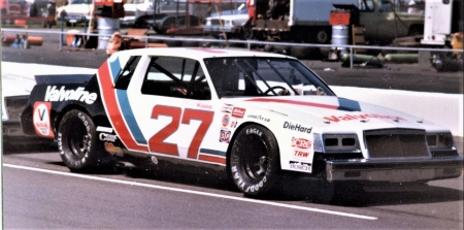
1981 Cup ride
2/100th of a second to grab the win. Yarborough was a team owner for 371 races, and such drivers as himself, Dale Jarrett, Dick Trickle, Lake Speed, Jimmy Hensley, Derrick Cope, Jeremy Mayfield, Greg sacks and others. They posted 13 top 5 finishes. Cale closed his team in 2000. For his race career Yarborough ran in 560 CUP events. getting 83 wins, and 255 top five finishes. He won the CUP Championship three consecutive times from 1976-1978. He also won the Daytona 500 four times, the FireCracker 400 (Daytona summer events) on three occasions. He claimed the Southern 500 win on five
occasions, had six wins in the 500 mile events at Atlanta, and won 16 of the 32 races held at Bristol and Nashville from 1973-1980. In 1984, he became the first driver to qualify for the Daytona 500 with a top speed of more than 200 miles per hour (it came on his first lap). On the second lap he got loose coming off of turn #4, and the car flipped and the car was destroyed. They had to go across the street from Daytona International Speedway to the Volusia County Mall to get their short track car that was on display for race fans to see. Yarborough still led a race high 89 laps, but would have to slingshot by Darrell Waltrip on the final lap to get the win using the short track car. Other career statistics include 27 IROC Series races in 8 different seasons. He won on five occasions. In 1984 he won the Championship for the special competitions between the Daytona 500 with a top speed of more than 200 miles per hour (it came on his first lap). On the second lap he got loose coming off of turn #4, and the car flipped and the car was destroyed. They had to go across the street from Daytona International Speedway to the Volusia County Mall to get their short track car that was on display for race fans to see. Yarborough still led a race high 89 laps, but would have to
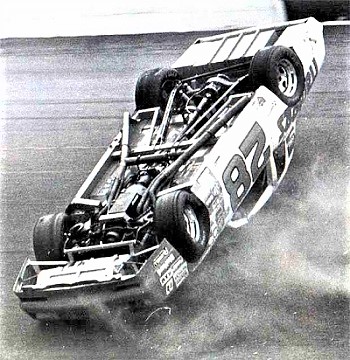
1984 Daytona 500 qualifying flip
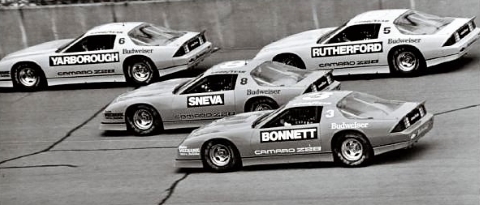
1984 IROC Series Michigan
slingshot by Darrell Waltrip on the final lap to get the win using the short track car. Other career statistics include 27 IROC Series races in 8 different seasons. He won on five occasions. In 1984 he won the Championship for the special competitions between the best drivers in all forms of motor sports and finished second in 1977. He also raced in 13 Indy car events; running 10 of the 12 races in 1971. Yarborough's best Indy car finish was fifth (twice -Michigan, and Trenton NJ). His best Indy 500 finish came in the #21 car (pictured above) when he started on the
last row and raced to a 10th place finish. This was his last Indy car start. His final race came in 1988 in the Atlanta Journal 500. Oddly enough; like in his final Indy Car start, Yarborough also finished 10th in his final stock car start. He also won a Cup race at Jefferson GA. at Jefco Speedway in 1968 (the track I was the flagman at for several years). Other awards Yarborough received was: 1967 Cup Series Most Popular Driver; 1977 American driver of the Year; voted one of NASCAR's 50 greatest drivers and voted into NASCAR Hall of Fame in 2012. Some info from Wikipedia
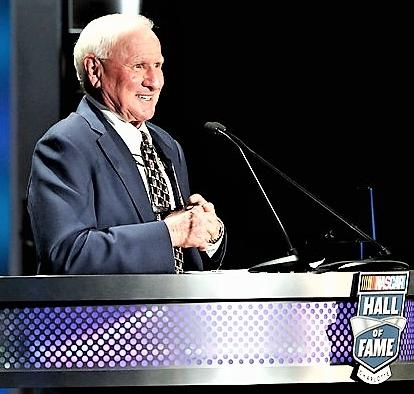

1983-1988 Cup ride
All Photos copyright and are property of their respective owners
